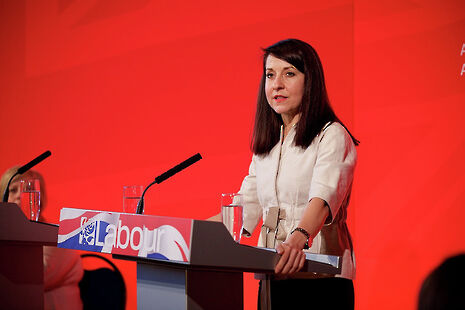Why Labour needs a female leader
In anticipation of the Labour party leadership elections in September, Imogen Shaw says its time for a female leader

In February 1975, whilst standing in the Conservative party leadership election, Margaret Thatcher said, “Forget that I’m a woman”. Sadly, that has since been proven impossible: to this day, she is defined as much by her gender as her ideology, because we still are yet to see another woman elected leader of either major political party.
For many women who support the Labour party, this is particularly disappointing. Technically, Labour has had two female leaders: Margaret Beckett and Harriet Harman, the latter of whom is again Acting Leader following Ed Miliband’s resignation. However, neither has succeeded in becoming more than ‘Acting’ Leader of the party. Beckett contested a leadership election from this position and lost to Tony Blair, never having been considered a front-runner.
This is not to belittle either woman’s personal achievements. Harman is currently the longest continuously serving female MP and has served as Deputy Leader of the Labour party since 2007. Beckett is one of the longest serving ministers in government history. Moreover, upon being appointed Foreign Secretary in 2006, she became only the second woman since Thatcher to hold one of the Great Offices of State.
However, that it took until 2006 for more than one woman to achieve this illustrates just how slow change takes to occur in the gender balance of government. Writing this at a time when the Labour party is forced to contemplate significant changes in the wake of unexpected, complete national defeat, it seems that now would be the best time for party members to elect their first female leader.
Of course the issues Labour face are more complex than any outcome of the leadership election will solve. It is imperative that we consider the voters who have supported the party before but who chose not to do so this time. Then, we must ask ourselves why this happened.
On the surface, the reasons appear disparate, as groups of voters who had in the past supported Labour, voted for various other parties – or not at all. A narrative gaining traction suggests Labour simply did not present a distinctively attractive, coherent enough alternative for a lot of people. To win elections, it appears Labour needs to widen its appeal in several directions.
However, September’s leadership election will still be crucial for the party. This is because we need someone who understands the need to connect with the various demographics to which Labour did not appeal this time: the ‘aspirational’ voters, groups such as small business owners who favoured the Tories.
Also, the working-class voters who don’t see the institution Labour is in danger of becoming as still representing them, whose votes for Ukip, or decisions to stay at home, led to Tory wins in a number of seats, Ed Balls being the most prominent Labour casualty. Addressing this won’t be easy, especially taking into account the rapid rise of the SNP, and a growing frustration amongst the further left, many of whom feel Labour takes their votes for granted.
To reiterate: no leadership candidate can or will solve any of these problems by the mere fact of their election. However, choosing a leader who stands for addressing them head-on, who is a fresh enough face to mark distinct change from the Blair-Brown years, will do Labour no harm. And, if that candidate is a woman, all the better.
This isn’t tokenism – Labour needs to present the electorate with a cogent, appealing, visibly different choice. This is the party that drastically altered the gender balance and, subsequently, the culture of parliament with the introduction of all-women shortlists. What better message to ‘aspirational’ voters than to demonstrate, in our choice of leader, a continuation of that legacy of breaking down social barriers to achievement? What better message to those who see Westminster as an elitist Old Boys Club?
Of the candidates who have announced their intentions so far, Liz Kendall is notable for suggesting Labour should not let the Conservatives become the sole party of “aspirations and ambitions”. She was also first elected in 2010, easily marketable as a clean break from the Blair-Brown era. However, that she is still described in the media as a potential “heir to Blair” casts doubt on her appeal to voters disenchanted with the party after the New Labour years.
Looking then to those who haven’t announced intentions to run, Lisa Nandy stands out as an exciting potential candidate. Like Kendall, Nandy was elected in 2010. Her work on the Modern Slavery Bill has seen her recognised as an original thinker and a force for change within the party. Moreover, she has publically expressed her view that politics needs to empower the masses, extending across society at an accessible, local level.
Labour needs to rebuild, and it could do a lot worse than demonstrate this in electing a female leader, with a strong, distinctive vision for its future.
 Interviews / ‘People just walk away’: the sense of exclusion felt by foundation year students19 April 2024
Interviews / ‘People just walk away’: the sense of exclusion felt by foundation year students19 April 2024 News / Copycat don caught again19 April 2024
News / Copycat don caught again19 April 2024 News / John’s spent over 17 times more on chapel choir than axed St John’s Voices22 April 2024
News / John’s spent over 17 times more on chapel choir than axed St John’s Voices22 April 2024 News / Climate activists smash windows of Cambridge Energy Institute22 April 2024
News / Climate activists smash windows of Cambridge Energy Institute22 April 2024 Theatre / The closest Cambridge comes to a Drama degree 19 April 2024
Theatre / The closest Cambridge comes to a Drama degree 19 April 2024





